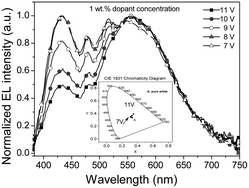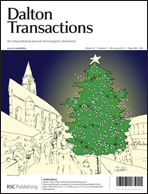A novel dinuclear platinum complex of (dfppy-mhb-dfppy)Pt2(acac)2 was synthesized and characterized, where dfppy-mhb-dfppy is a binary C^N cyclometalated ligand containing two bridged 2,4-difluorophenylpyridine (dfppy) units and acac is 2,4-pentanedione anion. Compared to previously reported dinuclear platinum complexes with a binary ancillary ligand, this dinuclear platinum complex showed more intense excimer emission, peaking at 617 nm, besides its intrinsic emission in dilute dichloromethane solution. Single-emissive-layer (SEL) polymer light-emitting devices (PLEDs) using (dfppy-mhb-dfppy)Pt2(acac)2 as dopant and a blend of poly (N-vinylcarbazole) (PVK) and 2-(4-biphenyl)-5-(4-tert-butylphenyl)-1,3,4-oxadiazole (PBD) as host matrix exhibited stable white emission at 1 wt% doping concentration under applied voltages from 7 V to 11 V. The stable white emission observed in the (dfppy-mhb-dfppy)Pt2(acac)2-doped SEL PLEDs indeed implies that the dinuclear platinum complex constructed by a binary cyclometalated ligand has a potential application in white-emitting SEL PLEDs.

You have access to this article
 Please wait while we load your content...
Something went wrong. Try again?
Please wait while we load your content...
Something went wrong. Try again?


 Please wait while we load your content...
Please wait while we load your content...